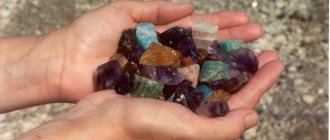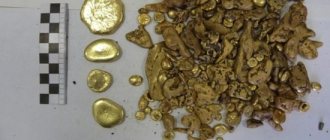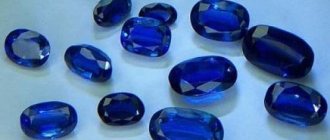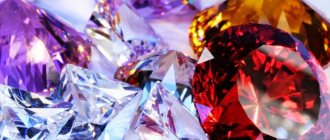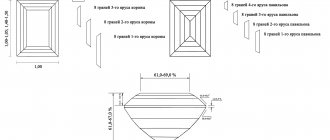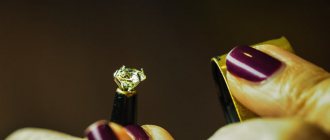Jewelry stones and gems are valued for their transparency, ability to refract light, or for their beautiful colors and intricate patterns in the case of opaque minerals. However, looking at samples extracted from the rock, it is difficult to see the beauty hidden inside. To show and emphasize the advantages of gems, the mined raw materials are subjected to additional grinding, polishing or cutting. It is stone processing that allows you to reveal the best properties of natural raw materials and increase their value.
What is stone refining
Natural minerals with high levels of transparency and rich color are very rare. Most of the mined raw materials have minor defects, uneven or pale color. To improve the quality and characteristics of jewelry stones, methods for refining them have been developed. Unlike natural gems, refined samples are cheaper. Moreover, the accompanying documents must indicate whether the mineral has been refined.
Refining is the processing of already cut crystals or natural untreated stone
It consists of a targeted physical and chemical effect on raw materials, as a result of which it is possible to achieve an increase in the key consumer qualities of minerals.
For example, jewelers have noticed that by heating clear or lightly colored amethyst crystals, which have a low market value, they can produce sought-after yellow stones that resemble citrines. Minerals with zonal coloring, called ametrines, have become popular: when amethyst is heated from just one side, the resulting crystal is yellow at one end and purple at the other.
The main methods of refining stones that are accepted in the jewelry industry and are considered acceptable:
- Annealing (heat treatment). As a result of exposure to high temperatures, many minerals acquire a more saturated color. This method is also used to remove unwanted tints (such as blue in rubies) or inclusions (such as rutile in sapphires).
- Oil treatment - used in cases where it is necessary to hide cracks. The refining process consists of injecting oil with a similar refractive index into the split, from which air and water have been pumped out. As a result, the cracks become almost invisible.
- Treatment with epoxy resin , like oiling, improves the transparency of samples and increases their strength.
- Radioactive irradiation is the main method for producing naturally occurring blue topazes, colored diamonds and quartz. Depending on the type of mineral, X-ray, ultraviolet, gamma radiation or exposure to a flow of energetic particles (neutrons, protons, electrons or alpha particles) is used.
- Coating allows you to obtain crystals with an unusual color, for example, after applying a thin film of precious metals to the surface of topaz, you get mystic topaz, characterized by iridescent tints.
How to care for jewelry - wooden, stone, silver
Jewelry has become an important attribute in the image of a modern woman. Necklaces and necklaces, beads, pendants, bracelets, earrings - all this wealth fills the endless boxes, boxes and cosmetic bags of a real fashionista. To ensure that your favorite accessories do not lose their original appearance, they need proper care.
In this article we will tell you about the basic rules for caring and storing wooden jewelry, as well as products made from natural stone and silver.
How to care for wooden jewelry
Let’s immediately dispel the myth that wooden jewelry is short-lived and quickly loses its visual appeal. With proper storage and basic care, the tree will serve you for many years.
Basic rules for careful storage of wooden jewelry
- Do not expose jewelry to mechanical stress. Try not to drop your wooden beads and bracelets on hard floors, especially concrete and tile floors. Dents or cracks will appear on the parts, decorative elements may fall out, which, you see, at best will not add attractiveness to the product, and at worst, serious damage may not be subject to further restoration.
- Store accessories separately from scratchy metal objects (tweezers, scissors, pendants with sharp edges). They can also cause damage;
- Avoid prolonged exposure to direct sunlight.
This will dry out the wood and it may change color or crack. The same applies to heating devices (central heating radiators, oil radiators). Even if your favorite beads or earrings get wet, do not dry them this way. It is better to dry the wood naturally, in a well-ventilated area. If your house is very hot and dry, put them in a box with a lid and put them in a dark corner; - Wooden jewelry does not withstand the effects of household chemicals and alcohol-containing liquids.
If you use products for styling and fixing your hair, as well as eau de toilette or perfume, take off your accessories, or better yet, put them on last, when your look is completely completed. Wood-destroying substances also include bleaches, filler for gel and ballpoint pens, felt-tip pens, markers, and medicinal alcohol solutions.
To understand the principle of care, you need to know the main ways manufacturers protect their products.
- Coating wooden parts with clear varnish
- Wax protection
With the first method, the strength of the product and its shine increase, with the second, the jewelry retains its natural texture and looks more natural.
Typically, souvenirs and jewelry made of ebony or mahogany are treated with wax. These breeds are very expensive, and it is extremely rare to find products made from them in Russia.
We used to call cherry wood mahogany, and black the dark brown color of some tree species, such as oak.
Under the influence of time and sunlight, beads can change their color - varnished beads, as a rule, become lighter (due to the destruction of the varnish layer), while those treated with wax, on the contrary, darken (due to oxidation processes).
How to properly update your appearance
To make your jewelry look attractive longer, periodically pamper your favorite earrings, necklaces and bracelets made of wood with caring treatments. The tarnished product is rubbed with a dry soft cloth or treated with natural oils. Olive or flaxseed will do.
You need to apply the oil to the surface, leave for 30-40 minutes, and then wipe with a terry towel or any other cotton cloth. Make sure that parts are not cleaned with abrasive agents.
If the decoration has carvings, accumulated dust can be easily removed with a regular paint (or blush) brush.
Caring for jewelry made from natural stones
There are a great many varieties of stone from which jewelry is made. All of them are divided into three categories:
- Jewelry (precious);
- Jewelry and ornaments;
- Ornamental.
Each category includes a specific list of minerals, which, in turn, are divided into classes. We will not go into detail into the classification of this natural material, but will consider the general rules for caring for jewelry made from natural stone, and also focus on several of the most common types.
Let's start with the fact that stones have different chemical compositions and physical properties, which means that some are very hard and are used to cut softer rocks (for example, diamond), while others have a more porous structure, therefore, numerous environmental factors the environment affects them many times more.
Therefore, the first rule will be to store jewelry separately. The ideal way is to have a personal velvet or fabric bag for each accessory. This will prevent softer minerals from being damaged by harder ones.
Most of the dirt accumulates in the places where the stone is inlaid and in the fasteners. You can remove everything unnecessary using a regular cotton swab dipped in warm water. Do not try to clean jewelry with sharp metal objects; you may scratch the mineral or damage the fastenings. It is better to use special products that are sold in jewelry stores for certain categories of minerals. The assortment is quite wide - foams, napkins, solutions.
The most difficult ones to care for are natural stones of organic origin: amber, pearls, turquoise, opal.
Let's look at them in a little more detail.
- Amber is a soft and delicate stone; caring for it requires special care.
It is extremely sensitive to chemicals and alcohol solutions, so do not wash dishes, do not clean items containing amber, and also make sure that drops of perfume or hairspray do not come into contact with it. Under the influence of all these substances, a white coating appears on the surface of amber, which is almost impossible to remove. Protect this fragile mineral from severe temperature changes and prolonged exposure to direct sunlight; - Pearls love moisture very much. With constant dry air, high temperatures and exposure to sunlight, it dries out and cracks. Also be careful with cosmetics and perfumes. Avoid getting them on the pearl beads. It is advisable to store a string of pearls in the shade, separately from other jewelry, wrapped in a soft cloth;
- Turquoise is a stone that tends to lose its color.
This happens due to the porous structure of the rock, which absorbs any evaporation of fats and oils. Avoid contact with turquoise jewelry with soap solution, creams and other cosmetics; - Opal is also a porous rock that does not like sudden changes in humidity and temperature. It may crack and lose its color and shine. Protect opal from mechanical stress and cleaning with abrasives. Treatment with glycerin will be beneficial for this stone.
When buying a piece of natural stone jewelry you like, ask the seller about the rules for caring for this particular mineral.
Caring for silver at home
Our parents cleaned silver items with tooth powder or soda. The immediate effect, of course, was noticeable, they brightened, but still, you should not rub silver with abrasive substances. This method destroys the polish, which is so necessary so that the jewelry does not lose its shine.
So that silver does not darken
- Do not store it in areas with high humidity (bathrooms, kitchens);
- Do not clean with chemicals;
- When preparing food, avoid metal contact with foods containing hydrogen sulfide (for example, eggs)
Also, the reason for the darkening of a silver item can be the illness of the person who wears it.
If the silver does turn black, there are several simple and effective ways to clean it.
Types of stone processing
Refining stones is just one of the stages of processing gems, which is not mandatory. Before falling into the hands of a jeweler and becoming part of a piece of jewelry, all jewelry stones go through a mandatory processing process. Its methods are selected depending on the basic physical and chemical properties of the mineral: transparency, hardness, presence or absence of a pattern.
Modern processing includes the following methods:
- Rock cutting is carried out on machines equipped with band, circular or cable saws. As an alternative to industrial sawing of mined rock, a laser is used for this purpose.
- Peeling - giving raw materials a preliminary shape.
- Grinding is an intermediate step that allows you to obtain a uniform surface roughness of the stone and better evaluate its shape.
- Polishing - reveals the pattern and structure of the mineral, for which grinding wheels are used with a coating of grinding powders.
- Cutting , together with previous methods, is an integral part of the processing of transparent precious stones, as a result of which it is possible to fully reveal the brilliance and light refraction of minerals.
- Polishing is the final stage, as a result of which the surface of the stone acquires a mirror shine.
- Engraving is a decorative processing option that consists of applying a design to a surface.
Bleaching
The use of chemicals to change or reduce the colors or porosity of the stone.
The most common bleached gemstones are:
Jadeite - Jadeite is often acid bleached to remove the unwanted brown component from the material. Bleaching of jadeite is usually part of a two-step process. Since the material becomes porous or brittle along the cracks after acid bleaching, it is then treated with a polymer impregnation to fill the cavities and achieve the best appearance.
These areas in jadeite show the material before and after bleaching.
Pearls - All types of pearls are usually bleached with hydrogen peroxide to lighten and improve the uniformity of their color.
Cultured pearls are usually bleached to achieve uniform color.
Detection
Whitening in a one-step process is almost undetectable in most cases. The second step, impregnation of polymer compounds, is easier to detect in a qualified gemological laboratory using magnification and more advanced analytical techniques.
In trade
Most often found in pearls and jadeite.
Durability Factor
Acid bleaching causes disturbances in the structure of most materials, making the materials brittle and vulnerable to breakage. In most cases, bleaching is accompanied by an impregnation treatment to improve strength and fix the perceived color.
Special care requirements
Bleached gemstones tend to be more fragile and more porous and thus more absorbent of human sweat and grease, oil and other liquids. Bleached pearls should be stored in a soft and dry environment to avoid surface damage.
Home processing tool
Processing natural jewelry or semi-precious stone at home may include cutting, polishing, engraving and grinding of gems. All actions should be carried out only with a continuous supply of water, which removes stone dust and cools the surface of the stone and tools.
Depending on the type of impact, the following tools will be required:
- continuous water supply system - you can use a sponge or a dropper;
- a cutting machine or grinder with diamond saws - for sawing hard samples;
- a hacksaw is suitable for soft stones, such as jet or amber;
- vice or clamp - for fastening the sample;
- grinding machine;
- the drill will help in making holes in stone, grinding and polishing, if you choose suitable attachments;
- the engraving set can be used both for drawing and polishing;
- sandpaper with different grain sizes;
- grinding and polishing discs of various textures;
- grinding powders and diamond pastes, for example, goi paste;
- quadrant - a device for measuring and setting angles of inclination, without which it is impossible to apply geometrically correct edges;
- kitch - a rod on which a crystal is attached during polishing or cutting.
Impregnation
The surface of the porous stone is impregnated with polymer, wax or plastic to give it greater strength and improve its appearance.
The most commonly found gemstones with this impregnation are opaque ones such as turquoise, lapis lazuli, jadeite, jade, amazonite, rhodochrosite and serpentine.
Porous precious materials, like this pale turquoise on the left, are impregnated with a wax or polymer substance, causing the color to deepen and improve durability.
Durability Factor
Many stones, due to the low melting point of plastic and wax, can be susceptible to heat. Plastic impregnations are considered durable in stones such as turquoise as long as they are not exposed to heat or chemicals.
Detection
In most cases, a qualified gemologist can easily determine treatment.
In trade
It occurs very often.
Care requirements
Care must be taken not to expose impregnated gemstones to heat; for example, when repairing a piece, a torch flame is likely to damage the stone.
Do-it-yourself sawing and stabbing
Processing precious and semi-precious stones is a compromise between two aspirations. On the one hand, it is necessary to maintain the maximum size and weight of the finished product, on the other hand, it is necessary to give it an ideal shape or cut, taking into account the structure and quality of the material. Based on these conditions, specialists involved in stone processing determine the required size and shape of the workpieces.
To split a piece of rock , you can use special devices, for example, a clamp with two teeth made of hardened metal. To split large pieces, you can drill holes or make a notch along the edge of the chip and successively punch the cut line using wedges and a hammer.
To cut rock yourself , you can buy a ready-made machine or assemble your own, for example, based on an electric drilling device, equipping it with a continuous water supply system. As such, you can use a moistened sponge or foam rubber, if you hold it with your left hand while cutting. However, to comply with safety precautions, it is better to use both hands during work, so under the workbench with a homemade machine, you can place a tray with water, which will cool the cutting saw blade.
If there are cracks in the sample that needs to be cut, they need to be sealed with epoxy glue for greater strength. This technology allows you to avoid unwanted splits of the material during the sawing process. Before pouring glue into the cracks, the stone must be heated on an electric stove so that the moisture evaporates. When the mineral has cooled to 60 ℃, you can apply glue, trying to ensure that it penetrates deeper into the fracture. When the glue dries, proceed to cutting.
After the raw materials are cut into pieces, they are sent for peeling, during which the workpieces acquire approximate sizes and shapes. For this purpose, coarse-grained grinding wheels are used.
Laser drilling
Using a narrow, focused beam of laser light to burn an open channel from the surface of the diamond, reaching the dark inclusions. The channel is then filled with a chemical to dissolve or change the appearance of the inclusion.
Diamonds are the only gemstones that are processed in this way, partly because they are the only ones that can withstand the high temperature of the laser.
Three holes were drilled through the facet of this diamond using a laser drill in an attempt to improve its clarity. However, it appears as if the holes created significant cleavage around the inclusion and actually made the inclusion more visible. This type of treatment does not always improve the clarity of the stone. Field of view 4.4 mm.
Detection
Easily detected by most gemologists and qualified gemological laboratories due to the presence of holes.
In trade
Sometimes they meet.
Care requirements
There are no special care requirements for laser-drilled diamonds.
Addition:
Here I disagree with the respected author. Using Israeli technology, laser-drilled holes are filled with liquid of organic origin. The refractive index of liquid is close to that of diamond. The hole is then filled. When repairing items with such treated diamonds, the burner flame may oxidize the organic matter and the channel will darken.
How to polish to a shine
If the refining of precious stones involves changing their properties, then polishing uses the qualities inherent in the mineral itself and emphasizes its natural advantages.
The main secret to successful polishing at home is a gradual change of abrasives: from larger to smaller ones. At the end of the process, it is better to use soft polishing pastes depending on the type of mineral.
Preparation for polishing
Polishing is the final stage of processing natural stone. After this, the gems can be used as inserts in jewelry and other jewelry.
Before you start polishing the stone yourself, it must be sanded. That is, its surface must first be leveled. This can be done either manually, using sandpaper wrapped around a hard base and moistened with water, or using a special tool.
For grinding, in addition to the machine, you can use a grinder or drill, on which you will need to install special attachments. The polished surface of the stone will be even and smooth, but still without a mirror shine.
To polish a mineral to a shine, you will need laps made of felt, leather or fabric , as well as polishing pastes or moistened fine-grained powders - chromium oxide, diamantine, diamond or tripoli. Materials should be selected depending on the characteristics of the raw materials being processed.
A popular method for polishing stones is felt combined with diamond powder, but it is not suitable for minerals with an irregular structure such as fibrous or grainy. Because they are prone to underpolishing: holes or protrusions often form on their surface. To polish such minerals, it is better to use wood or leather.
How the process works
The final processing of the surface of a jewelry stone takes place in several stages:
- To prepare the polishing surface for work, you need to moisten it with water and a small amount of detergent.
- You need to let the polisher run idle so that the moisture is evenly distributed and the excess is removed.
- Apply diamond powder to the faceplate.
- Moving from the center to the edge, they begin to polish the product, pressing it with force against the surface of the faceplate.
- As the surface dries, friction will increase and more effort will be required to hold the crystal.
- To prevent overheating of the working surface, water should be periodically supplied to it. In order to correctly adjust its feed, it should be borne in mind that the harder the stone, the more pressure and the drier surface of the faceplate it requires to be polished.
- Finally, you need to polish the surface with a soft material, such as felt.
During operation, it should be taken into account that if the grinding machine has the ability to change the rotation speed, then in order to avoid underpolishing of the samples, it is necessary to select indicators within the range of 500–2000 rpm.
Processing stones at home is an interesting hobby that can generate income. Working with precious minerals requires certain skills and knowledge. However, in addition to gems, simpler stones, such as cobblestones or pebbles, are also processed: their surface can be engraved, and beautiful samples can be used in interior or garden design.
Preliminary preparation
Before starting work, you should check the softness of the stone to see if it is suitable for polishing. To do this, take a pocket knife and try to carefully scratch the surface. If there is a white mark left or a grainy mark, the stone is not suitable for work; polishing will make it loose. If there is a shiny mark left, the stone is hard and you can work with it.
When checking, you must hold the knife away from you and do not press it too hard - it may slip.
If it is necessary to polish a found stone, first it is given the desired shape using a chisel and hammer. If the stone is large, with large ridges, the ridges will need to be chipped away. At the end, you need to rinse it and remove all dirt.
Source ratatum.com
General information
Artificial stone, identifying the pros and cons
The price of artificial stone is lower than that of natural stone. But at the same time, it is not only not inferior to the latter, but also superior in some respects.
There are two types of artificial stone: acrylic and agglomerate.
Acrylic stone - consists of acrylic resins, crushed minerals or acrylic and dyes.
Advantages of acrylic stone:
- — presentable appearance, perfectly imitates natural stones;
- - easy to care for;
- — the material is very plastic, so it is suitable for making the most unusual shapes;
- - a huge range of designs and colors;
- — surface without joints, warm and pleasant to the touch;
Disadvantages of acrylic stone:
- — the material is easy to damage;
- — scratches and other minor external defects are visible on dark, plain glossy surfaces;
- — if alkalis, lemon juice, or food colorings come into contact with the surface, stains may form.
When choosing an acrylic tabletop, we advise you to give preference to light colors, and also study the rules of its use in advance so that the tabletop retains a beautiful, fresh look for as long as possible.
Agglomerate - the material consists of 90% natural stone chips (quartz, granite, marble), the binding base is polyester resin. This combination of components makes the agglomerate especially durable. In addition, the composition includes special pigments, mirror particles, which give the agglomerate a resemblance to natural material.
Advantages of agglomerate:
- - cheaper than natural stone;
- — spectacular and presentable appearance;
- - It does not require special care;
- - the material is strong and durable;
- — the agglomerate is resistant to mechanical damage, high temperatures, dyes and acids;
Disadvantages of agglomerate:
- — the material has a high density, so it is complex and labor-intensive to process;
- — seams on the surface;
- -You cannot use abrasive detergents, because they leave small scratches on the surface;
- - it is possible to restore a countertop from agglomerate only with special training and equipment;
- — small selection of colors;
- — the material feels cooler to the touch than acrylic.
Thus, agglomerate is the most durable and durable material, but is not suitable for the manufacture of countertops of complex shapes.

